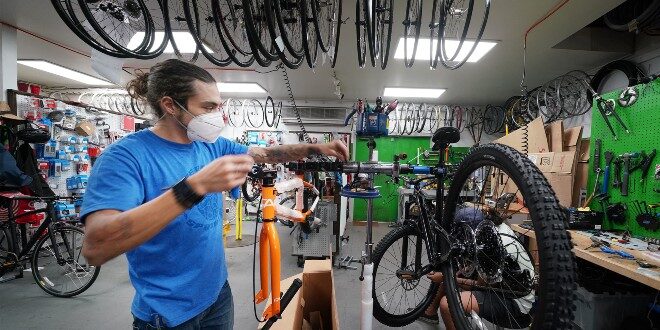Following the lifting of the UK’s third lockdown, the ACT has released further guidance for bike shops that are now reopening after making the difficult decision to shut up shop in the interests of safety for themselves, their employees and their customers. Since closure, it may now be difficult to know how to safely reopen in a way that satisfies all safety requirements…
It is critical to point out that outside of the recommendations below, it is the responsibility of each business to decide the most appropriate methods to implement social distancing and other COVID-19 control measures in their business. The business leader must maintain an open dialogue with colleagues to reassure and discuss any concerns with the safety of their role. First and foremost, please consider your own safety and the safety of your staff before choosing to reopen.
The Government has recently issued guidance to help businesses in the UK get back up and running and workplaces operating as safely as possible. The guidance is broken down according to the type of workplace rather than sector, with specific guidance relevant to bicycle shops being summarised alongside the ACT issued guidance below. The full Government guidance on working safely during COVID-19 in shops and branches can be found here.
Workforce management
Create distinct groups of workers to minimise the number of contacts each colleague has. Minimise person-to-person contact during deliveries and minimise contact during exchange of documentation. Clearly communicate changes in workplace policies and procedures, avoiding face-to-face interactions where possible.
It may be an idea to adapt the way your business operates to reduce contact with customers further, while still providing essential services. This could be done by continuing business with reduced in-store staff by:
– Managing the retail side of your business online, with customers buying through your website and collecting in store.
– Managing the workshop side of your business on an appointment-only basis.
– Delivering and collecting bicycles to and from customers’ homes. More information on how to do this can be found in the Operational Advice for Mobile Mechanics.
Social distancing at work
A distance of two metres should be kept between all staff and customers at all times. Social distancing should also be implemented when receiving and handing bikes over as part of a repair or service – it might be an idea to exchange bikes outside where possible, as well as wiping bikes down with antibacterial wipes or spray after being handled.
Outside the store
Limit the number of customers in the store at any time. The layout and size of the store will dictate how many customers you will be able to have in store at any one time.
– For small shops that may only be able to accommodate one to two customers in-store, a one in one out rule should be implemented. This will likely involve outside queueing.
– Consider having separate entrance and exit points if possible. We recognise that for many shops this will not be practical but if it is possible please do so.
– Use one staff member to manage queues outside (if available) and to explain the social distancing requirements and control the number of customers entering the store at any one time.
– Place clear signage outside of the store explaining the social distancing measures in place that customers should follow.
– Liaise with neighbouring stores/shopping centre management to ensure that your queuing systems operate effectively and, where practical, implement shared queuing areas.
– Place markings outside the store to assist in queue spacing.
– Encourage customers to shop alone wherever possible. Please bear in mind that this is not always possible especially for customers with children, disabilities etc.

Inside the store
– Provide cleaning options at front of store and on the counter. This could be hand sanitiser, disinfectant wipes or other options.
– Increase the amount of cleansing of the shop. The retail areas and workshops of your shop, especially all contact points such as doors, handles and surfaces, should be cleaned regularly and after every time they are touched.
– Use floor markings inside to facilitate compliance with the social distancing advice of two metres, particularly in the most crowded areas and where queueing is likely (this may not be necessary if only one person is allowed in the store at any one time).
– Place clear signage throughout the store reminding customers of the social distancing measures and asking them to follow these rules.
– Ensure aisles can accommodate two metres social distancing (if this cannot be accommodated you will need to put in place a one in and one out rule).
– Larger stores should implement one-way systems using floor markings and signage.
– Leave non-essential doors open to minimise the number of people who touch them.
– Try and keep to contactless payments where possible. Card contactless payments can be made for transactions up to £30 or £45 depending on your terminal provider. There is no limit on phone payment apps such as Apple Pay or Google Pay. The ACT has provided a poster that retailers can print out to put on display in their stores.
– If you have a customer toilet, we suggest these should be shut.
Inbound and outbound goods
– Consider whether the frequency of deliveries can be reduced by ordering in larger quantities less often.
– Where possible, have a single colleague load or unload vehicles or use consistent pairs of colleagues.
– Try to implement non-contact stock deliveries by encouraging drivers to stay in vehicles during the exchange of goods.
– Schedule deliveries if possible to avoid crowding. If they can be outside of opening hours this is beneficial.
– Deliveries should be via a back door where possible.
Messages for customers and those looking to cycle
It is important that customers are aware of the measures you are putting in place so that they can follow them.
– Inform your customers of updates and the measures in place. You should contact your customers, either via email or through your social media channels, of the measures you have in place regarding social distancing. It is also worth updating them on opening times if these are different to usual.
– Put up signage in key places. If you put in place any measures that prevent people just walking in, as suggested above, then it’s a good idea to put a poster on the front door making customers aware of this.
Customers looking to use their bikes during this period should be responsible.
– Encourage customers to cycle responsibly. This includes only cycling when travelling to and from work, to shop for necessities, to exercise or to travel to an outdoor space.
– Remind your customers not to cycle in groups. Everyone should be avoiding social gatherings, and this includes group rides. If using cycling to exercise or to travel to an outdoor space, this should be done either alone, with those you live with or with only one other person from another household. If choosing to ride with one other person from another household, then a two-metre distance should be kept between each other as a minimum at all times.
Implementation of a workplace testing programme
The Government has produced guidance for employers that should be taken into account before testing is implemented. It advises employers to:
– Consider the scope of any testing programme, including who will be tested, frequency of testing, arrangements for individuals who refuse to be tested and how test results will be used.
– Think about how they intend to communicate with staff about the testing programme. Employers are “strongly advised” to consult with staff associations or unions before implementing any policy.
– Be aware of their data protection obligations in processing data and how they will communicate to staff how personal data will be used.
The guidance advises that any individual identified as a contact through such an internal system (as opposed to NHS Test and Trace) will not qualify for SSP but instead should be allowed to work from home if possible. Where that is not possible, the guidance advises that individuals may be entitled to full pay unless their employment contract provides otherwise.
Other issues you will need to consider are whether you will operate an internal tracing system to identify those during their employment who may have come into contact with an employee who has tested positive as a result of the testing programme.

Home testing
The Department for Health and Social Care (DHSC) recently announced that home testing for COVID-19 has been expanded to businesses with over ten employees. From 6th April, the workplace testing programme will supply home test kits to companies with over ten employees where it is not possible to set up testing on-site, due to a lack of space or because companies operate across multiple sites.
Home testing kits will be picked up by staff from their employer with clear instructions about how to take the test. Staff will then complete the home test in the normal way, before reporting their results to the NHS using the provided gov.uk address. Employers with fewer than ten people are currently being encouraged to access regular testing through the community testing programme, now offered by all local authorities in England.
Let the UK know that you are open
An online map and postcode search facility at openbikeshops.uk has been set up to highlight bicycle shops that remain open during the COVID-19 outbreak. It enables key workers and others who need their bikes fixed for essential journeys, or for exercise, to quickly locate retailers and repairers who are open for business. Some retailers will have decided to open by appointment-only, or workshop-only, or perhaps on a deliveries-only basis. The exact extent of opening will be clearly indicated so that customers are fully informed.
This service is completely free of charge for all retailers, irrespective of ACT membership. Retailers are encouraged to confirm their opening status ASAP at openbikeshops.uk/trade. This process is very quick and easy: most shops will find their contact details etc. are auto-completed when they enter their postcode. Opening status can be easily revised later if circumstances change.
 BikeBiz Bicycle and cycling retail news
BikeBiz Bicycle and cycling retail news




